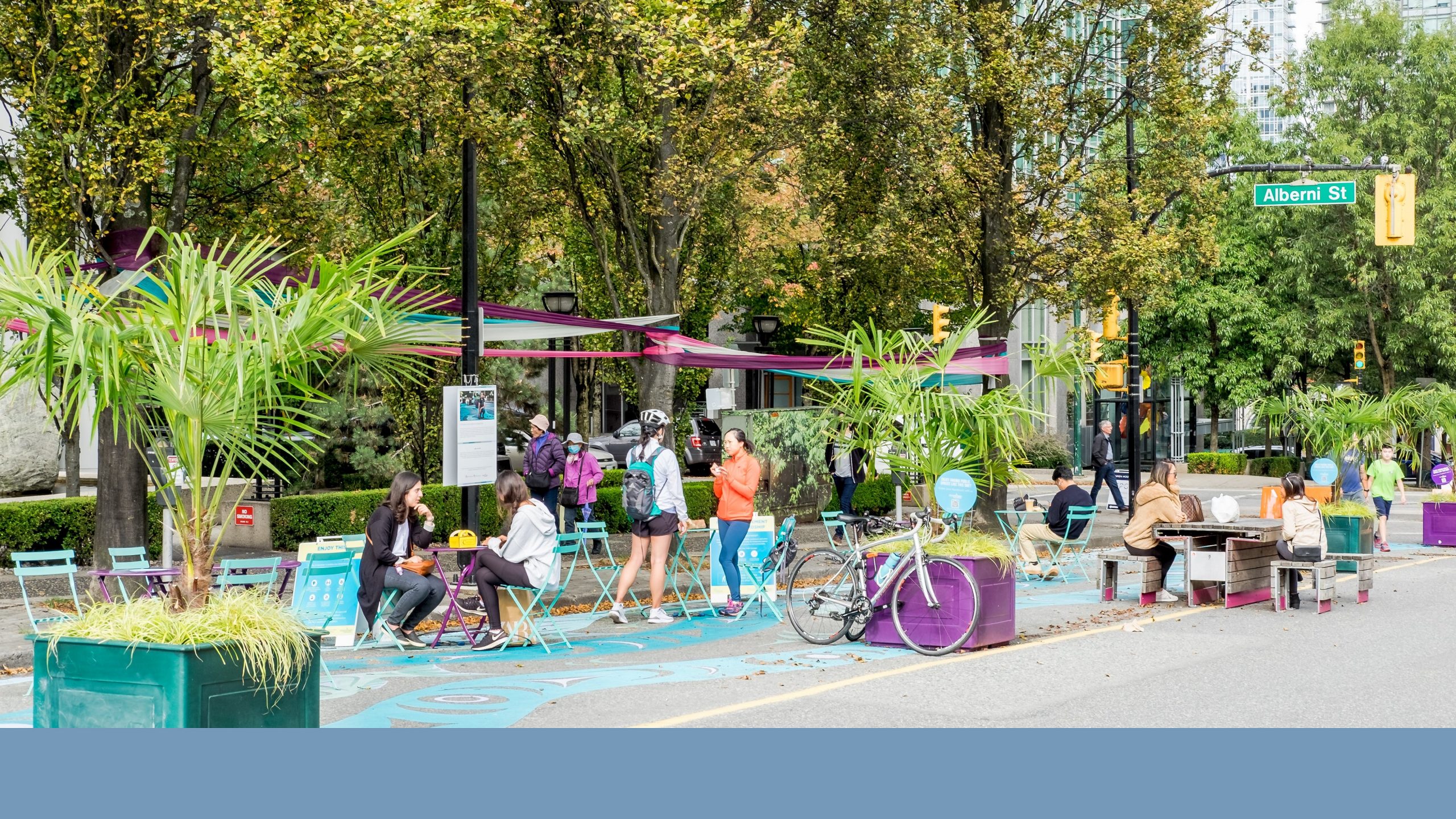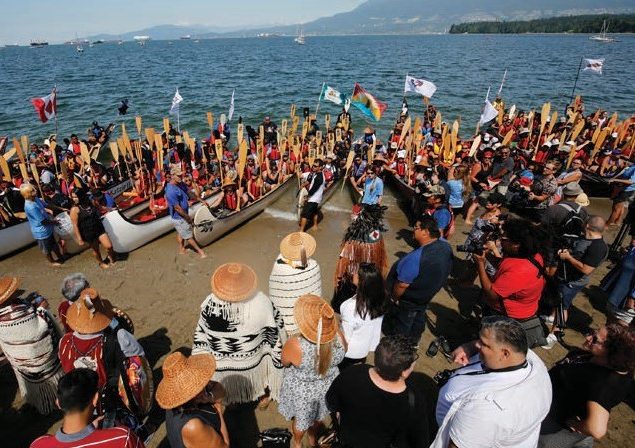
Direction 9.1: Indigenous Stewardship
Support the Nations in shaping public spaces.
Ongoing colonial practices continue to impede Indigenous Peoples’ rights, visibility and voice. Reconciliation efforts and strengthening relations with the Nations and urban Indigenous Peoples are fundamental to the City’s stewardship of public spaces. The City commits to work with the Nations to identify, participate in, and lead public space projects and ongoing management.
Policies
| 9.1.1 |
Work with the Nations to identify, prioritize, lead and deliver public space projects, where appropriate. |
| 9.1.2 |
Seek opportunities to create public spaces specifically designed for the Nations’ use, including land and water access, artistic and cultural expression, and traditional harvesting. |
| 9.1.3 |
Explore opportunities to integrate the hən̓q̓əmin̓əm̓ and Sḵwx̱wú7mesh languages in public spaces, including naming spaces, as led by the Nations. |
| 9.1.4 |
Work with urban Indigenous communities and organizations to support their public space priorities, and work with the Nations to ensure that local protocols and procedures are followed, where they deem appropriate. |
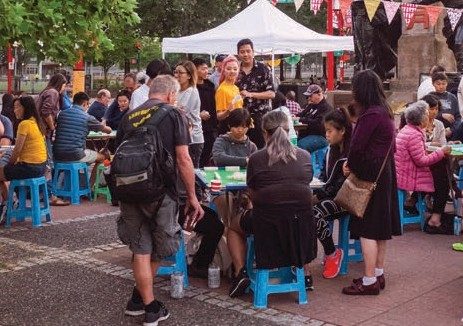
Direction 9.2: Inclusive Public Life
Promote an inclusive public life, by prioritizing underserved areas and equity-denied groups.
Communities and individuals who are racialized may face barriers to participating in public life and lack representation in public spaces, as do those who are marginalized because of their sex, gender identity, sexuality, background, ability, age, and/or economic status. To build truly welcoming, inclusive, equitable, and culturally vibrant public spaces, the City must work with equity-denied groups to understand and prioritize their needs, and perceptions of safety, and put underserved areas first.
Policies
| 9.2.1 |
Meaningfully engage equity-denied communities to better understand their experiences of public spaces, and prioritize their preferred uses and perceptions of safety in public space planning and design. |
| 9.2.2 |
Prioritize underserved areas and communities when identifying public space projects and investments. |
| 9.2.3 |
Recognizing that public space improvements and programming can displace street-involved and homeless persons and sex workers, ensure engagement with existing communities and outreach staff to better address their needs. |
See: Chapter 8, Arts, Culture, and Heritage – for Cultural Redress Areas/Sites
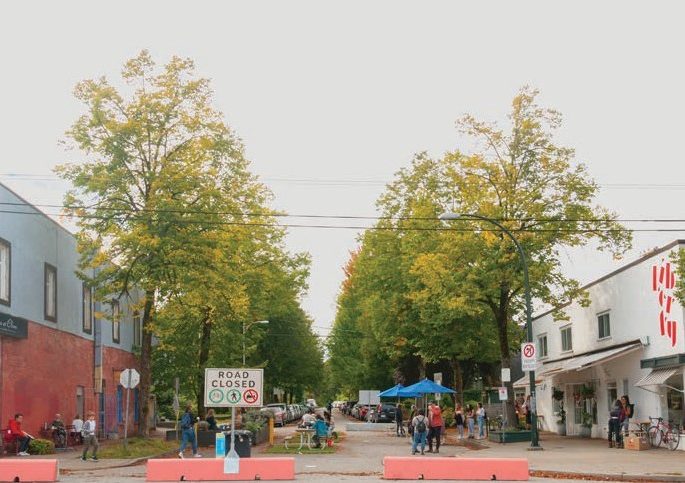
Direction 9.3: Grow and Enhance the Network
Grow and protect the public space network, to provide ample, high quality public spaces and robust connections across all neighbourhoods.
Public spaces must accommodate a broad range of uses and activities. However, a limited land supply, increasing density, and limited tax dollars, constrain the City’s ability to deliver and maintain public spaces. Creative and flexible approaches will be necessary to grow and protect the public space network, including innovating strategies for land acquisition, partnerships on private property, and the creative reuse of streets.
Policies
| 9.3.1 |
Identify opportunities to provide a full spectrum of public space types and uses for each neighbourhood, to support: gathering and social connection; cultural expression and celebration; civic action and democratic expression; respite and connection to nature; physical activity, health and well-being; food security and local economic vibrancy. |
| 9.3.2 |
Ensure the public space network provides easy and enjoyable connections to landmarks and attractions, to and through neighbourhoods, and to green spaces. |
| 9.3.3 |
Explore how the existing street network can create more space for ‘people first’ uses and natural habitat. |
| 9.3.4 |
Deliver new and renewed public spaces through development (including large site development), rezoning and land acquisition, where there is an identified need. |
| 9.3.5 |
Update land use policy to support more public space delivery through private property development, where feasible (e.g., privately owned public spaces or ‘POPS’). |
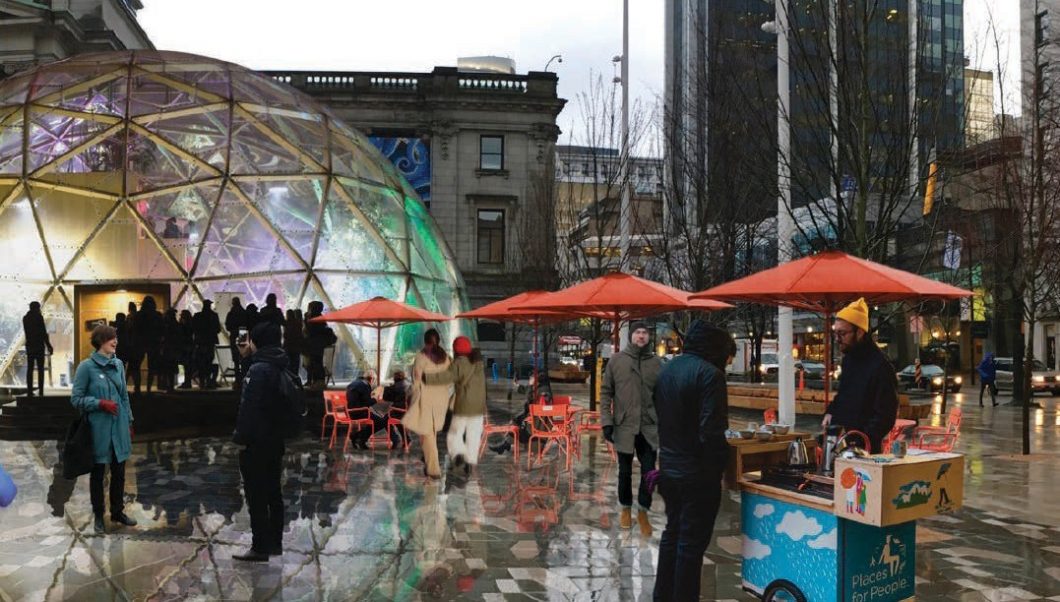
Direction 9.4: Universal, Safe, All-season Design
Create universally accessible and safe public spaces that are dignified and comfortably accommodate all people, throughout the day and across all seasons.
For many Vancouver residents public space often serves critical functions in their daily lives, including access to services and neighbourhood connections. Public spaces need to be dignified, universally accessible and comfortable for people all year round, in all weather, and provide core infrastructure to support basic needs.
Policies
| 9.4.1 |
Establish accessibility as the baseline for public spaces. |
| 9.4.2 |
Provide critical infrastructure to support public life (e.g., seating, power, lighting, and access to public washrooms, drinking water and misting stations). |
| 9.4.3 |
Incorporate weather protection, weather- mitigating elements, and appropriate programming for rain/winter and summer/heat conditions. |
| 9.4.4 |
Encourage safe and welcoming evening experiences in nightlife areas, and encourage a greater diversity of activities in the adjoining public spaces. |
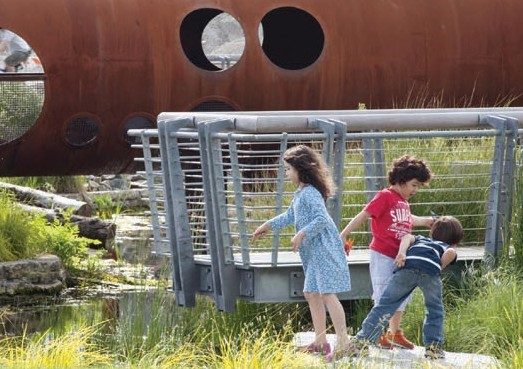
Direction 9.5: Nature, Ecology & Resilience
Ensure the public space network supports the City’s social and ecological resilience.
The public space network that includes parks, playgrounds, plazas, streets, sidewalks, and laneways, is an extensive land base in Vancouver, and thus a significant opportunity to respond to climate change. Where possible, we will repurpose portions of these areas for habitat protection, rainwater management, heat island mitigation, disaster response planning and active transportation.
Policies
| 9.5.1 |
Integrate natural assets and ecosystem services into the public space network to increase neighbourhood resilience and improve the city’s ecological health. |
| 9.5.2 |
Design public spaces to be responsive to the natural environment, and recognize the Nations as leaders of environmental and ecological protection. |
| 9.5.3 |
Explore the use of public spaces as response hubs, to support Vancouverites in times of earthquakes, flooding or other natural disasters. |
| 9.5.4 |
Enable residents to connect through sharing and growing food by creating food and medicine gardens and outdoor picnicking facilities in public spaces. |
| 9.5.5 |
Integrate active transportation and micro-mobility into the public space network, including public bike share, to better connect neighbourhoods and key destinations. |
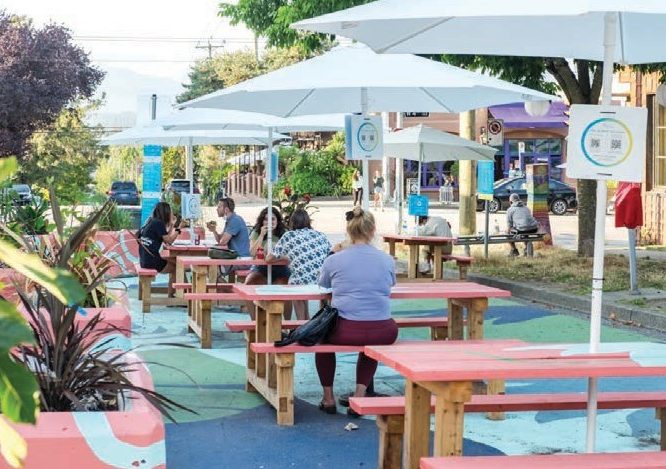
Direction 9.6: Community Partnership
Build and invest in community partnerships, fostering broader participation and social connection, and promoting resilient, community-led stewardship of public spaces.
Community involvement is critical to the success of public spaces, as residents, community organizations and businesses have immediate knowledge of the public space needs in their local neighbourhoods and can help drive the delivery of local programming, events and place-making in public spaces. The City must continue to build partnerships, and empower community stewards to co-manage public spaces by providing them with the right tools, including outreach and education, staff support, and sufficient service levels.
Policies
| 9.6.1 |
Partner with community organizations, non-profits, event organizers and local businesses to co-manage public spaces in their neighbourhoods, and develop outreach, education and communication tools, as part of an inclusive public space management approach. |
| 9.6.2 |
Expand the opportunities for lower barrier work through public space programming, stewardship and vending. |
| 9.6.3 |
Design public spaces with built-in flexibility and infrastructure to accommodate a wide range of uses, and to allow communities to evolve the spaces over time. |
| 9.6.4 |
Lower barriers to public participation in community-led place-making and programming, by improving coordination between jurisdictions, and strengthening communication tools, programs and funding. |
